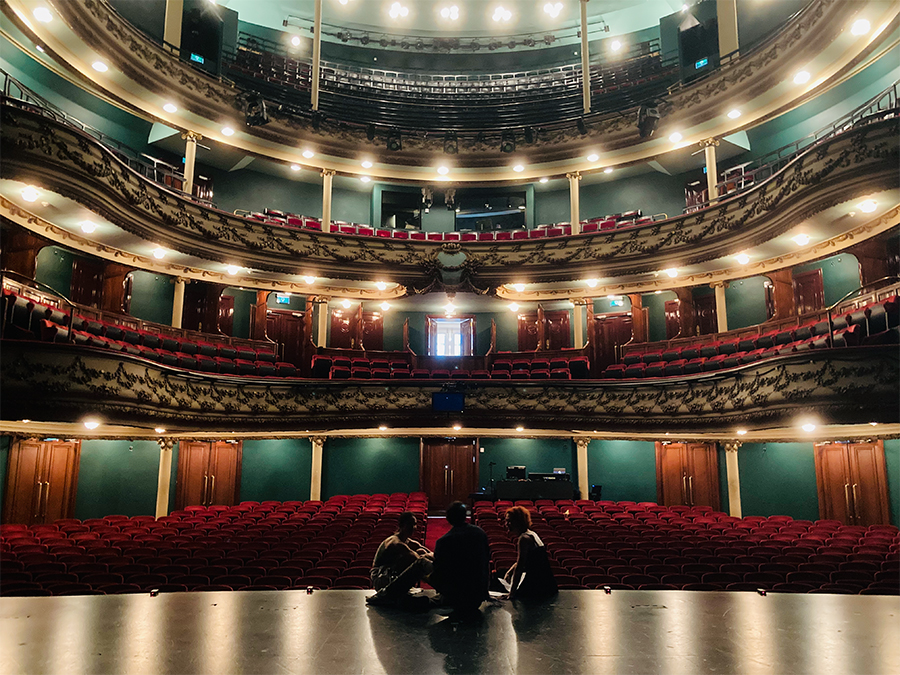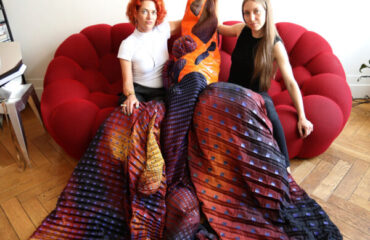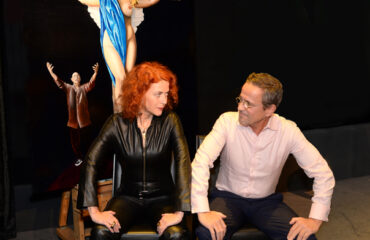Text: Dr. Elke Backes
October 4th, 2023. One day has passed since the world premiere of the dance spectacle New Ballet mécanique (choreographed by Richard Siegal) and resumption of Half life (choreographed by Sharon Eyal), which, like all other spectators, put me in a trance.
How can I transfer these fantastic performances into words? Ballet, first in dialogue with the sound-space installation by the artist Zimoun, and then in dialogue with the hard techno beats by Gai Behar. What a contrast!
What connection is there between these seemingly completely different pieces, and why did Jan Vandenhouwe, the artistic director of Opera Ballet Vlaanderen, choose this extraordinary combination?
Above: Scenes from New Ballet mécanique, below: Half life (Photos: Filip van Roe).
The title New Ballet mécanique provides the first clue: it is a reference to the original Ballet mécanique, a Dadaist silent film by Fernand Léger, Man Ray and Dudley Murphy from 1924. The accompanying music, composed by George Antheil, is considered a turning point in 20th-century music. The film was created at the peak of the industrial revolution and illustrates the boundaries between humans and machines. Nearly a hundred years later, we are in the era of the digital revolution. How have the movements of dance changed? Does classical ballet still fit into our time, and what role does the stage play in this context?
For Zimoun, whose site-specific, often large-scale works grace significant art venues worldwide, this marks his first production on a stage. Zimoun is known for using simple everyday objects, which through their repeated use develop an architecture and generate movement and sound through the application of kinetic principles.
In New Ballet mécanique, oversized cardboard boxes and barrels interact with the choreography and stage, producing sounds reminiscent of industrial halls through their movement. These objects seem to have a life of their own and attempt to dominate the stage, which the dancers continually strive to reclaim. When such a moment is achieved, the cacophony stops, and only the dancers’ light steps and breaths are audible. These moments are then replaced by the loud assault of the next formation of objects. Could this perhaps tell the story of the struggle between humans and machines?
Combined with the perfectly orchestrated lighting by Matthias Singer and the costumes gently flowing around the dancers’ bodies by Flora Miranda [see also ART DIALOG, August 30, 2023], this storytelling evidently utilizes all the possibilities of theater and the stage. Or, as Richard Siegal says: “… the stage, functioning as a machine, is taken as the starting point, as a magic box you can move in.”
Scenes from New Ballet mécanique (Fotos: Filip van Roe).
After the intermission, the contrast follows: no stage design, nearly transparent costumes, focused lighting on the dancers, pulsating techno sound, and off we go with Half life…
The immense sound, composed by Gai Behar, is literally embodied by the dancers in Sharon Eyal’s choreography. Every tiny gesture, executed with the precision of a machine, seems like an impulse reacting to the respective beat. The dancers appear remotely controlled, staccato-like or flowing in their movements, transforming alternately into an army of robots or giant science fiction insects.
Scenes from Half life (Fotos: Filip van Roe).
While in the first piece, mechanical technology dominated the stage, in Half life, it is clearly the digital that seeks to dominate and tells the story of the struggle between humans and machines in this contemporary era. A connection that is especially evident in retrospect due to the strong contrast between the productions.
And what role does ballet itself play in these narratives?
I ask the dancers Kirsten Wicklung and Shane Urton, and the choreographer Richard Siegal, who is preparing the first premiere of the new season in parallel with this schedule, with his Ballet of Difference in Cologne [for more information, see the link at the end of the article].
Left: in conversation with Richard Siegal, right: with Kirsten Wicklung and Shane Urton.
E.B.: Is there a connection between the development of technology and dance?
Richard Siegal: Absolutely. This is primarily due to today’s possibilities for exploring the human musculoskeletal system. The insights from biomechanics, the science of the body, have exploded the human movement potential. The force, precision, and coordination we saw today would not have been possible a hundred years ago.
E.B.: Is the precision of dance in both pieces also a demonstration that we function on the same principles as a machine?
Kirsten Wicklung: Yes and no. The major difference from a machine is that the human body is also subject to daily variations. There is therefore no continuous perfection. For us, this means having to adjust ourselves anew time and again.
Shane Urton: However, a similarity to the machine can be found in the control of energy, especially in Half life. The enormous energy discharged by the grooves of electronic music challenges us to dance excessively, but we must – to maintain tension – constantly pull back and resist this energy.
Definetly an enourmous energy has been unleashed here through the interaction of all participants on the stage. A stage that, during these performances, has also revealed itself as a central wheel in the machinery between humans and machines – as a mobile magic box, played in the most professional manner.
Don’t wait to save your tickets. It NEEDS the live experience!
Further Information
Information about the upcoming performances: https://www.operaballet.be/en/programme/season-2023-2024/new-ballet-mécanique-half-life
about Zimoun: https://www.zimoun.net/
Premiere NOISE SIGNAL SILENCE of Ballet of Difference on October, 27th at Schauspiel Köln, Depot I: https://balletofdifference.com/agenda
ART DIALOG with Flora Miranda: https://www.elkebackes-artdialog.com/generatives-design-in-seiner-magischsten-form-flora-mirandas-haute-couture-traumwelten-zwischen-technologie-mode-und-kunst/







